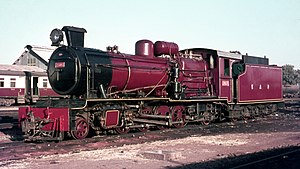From Wikipedia, the free encyclopedia
Tanganyika Railway ML class East African Railways 26 class No. 2603 at
Tabora depot, Tanzania, in 1968
Type and origin Power type Steam Builder Serial number WGB: 2832–2837 (1947) VF: 6182–6187 (1952) RSH: 7444–7449 (1952) Build date 1947, 1952 Total produced 12
Specifications Configuration: • Whyte 2-8-2 • UIC 1′D1' h2 Gauge 1,000 mm 3 ft 3+ 3 ⁄8 in )Driver dia.43 in (1,092 mm) Adhesive weight 39.0 long tons (39.6 t) Loco weight 51.8 long tons (52.6 t) Fuel type Oil Fuel capacity 1,300 imp gal (5,900 L; 1,600 US gal) Water cap. 4,200 imp gal (19,000 L; 5,000 US gal) Firebox: • Grate area 27 sq ft (2.51 m2 ) Boiler pressure 180 psi (1.24 MPa) Heating surface: • Firebox 139 sq ft (12.9 m2 ) • Tubes 2 ) • Total surface 1,731 sq ft (160.8 m2 ) Superheater: • Heating area 321 sq ft (29.8 m2 ) Cylinders 2 Cylinder size 17+ 1 ⁄2 in × 23 in (444 mm × 584 mm)
Career Operators Class TR: ML class EAR: 26 class Number in class 12 Numbers TR: 700–705/600–605 EAR: 2601–2612 Delivered 1947, 1952
The TR ML class , later known and expanded as the EAR 26 class , was a class of 1,000 mm 3 ft 3+ 3 ⁄8 in ) gauge 2-8-2 steam locomotives designed for and ordered by the Tanganyika Railway (TR), as a development of the TR MK class .
The six members of the ML class were built in 1947 by W. G. Bagnall , in Stafford , England, and delivered to the TR. They were later operated by the TR's successor, the East African Railways (EAR), as its 26 class. In 1952, six further members of the 26 class were delivered to the EAR. They had been built by Vulcan Foundry , of Newton-le-Willows , Lancashire (now part of Merseyside ), England, and Robert Stephenson and Hawthorns of North East England .
Class list [ edit ] The builders number, build year and fleet numbers of each member of the class were as follows:
Builders
Built
1st TR
2nd TR
EAR
Notes
2832
1947
700
600
2601
2833
1947
701
601
2602
2834
1947
702
602
2603
2835
1947
703
603
2604
2836
1947
704
604
2605
2837
1947
705
605
2606
6182/7444
1952
–
–
2607
6183/7445
1952
–
–
2608
6184/7446
1952
–
–
2609
6185/7447
1952
–
–
2610
6186/7448
1952
–
–
2611
6187/7449
1952
–
–
2612
See also [ edit ] References [ edit ] Bibliography [ edit ]
Durrant, A E; Lewis, C P; Jorgensen, A A (1981). Steam in Africa . London: Hamlyn . ISBN 978-0-600-34946-4 OCLC 9014344 . OL 15088099M . Wikidata Q111363476 . Patience, Kevin (1976), Steam in East Africa: a pictorial history of the railways in East Africa, 1893-1976 , Nairobi: Heinemann Educational Books (E.A.) Ltd, OCLC 3781370 , Wikidata Q111363477 Ramaer, Roel (1974). Steam Locomotives of the East African Railways . David & Charles Locomotive Studies. Newton Abbot, North Pomfret: David & Charles . ISBN 978-0-7153-6437-6 OCLC 832692810 . OL 5110018M . Wikidata Q111363478 . Ramaer, Roel (2009). Gari la Moshi: Steam Locomotives of the East African Railways . Malmö: Stenvalls. ISBN 978-91-7266-172-1 OCLC 502034710 . Wikidata Q111363479 . Staff writer (December 1956). "The "26" Class Locomotives" . East African Railways and Harbours Magazine . 2 (12). East African Railways and Harbours : 420. Retrieved 9 December 2014 .
External links [ edit ] TR ML class at Wikimedia Commons

![]() Media related to TR ML class at Wikimedia Commons
Media related to TR ML class at Wikimedia Commons
